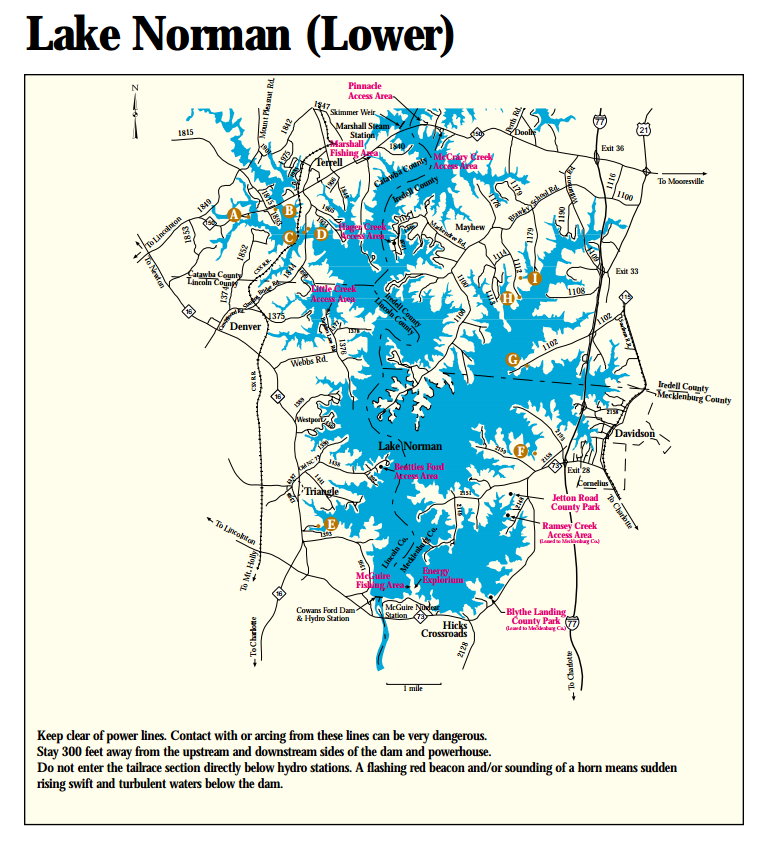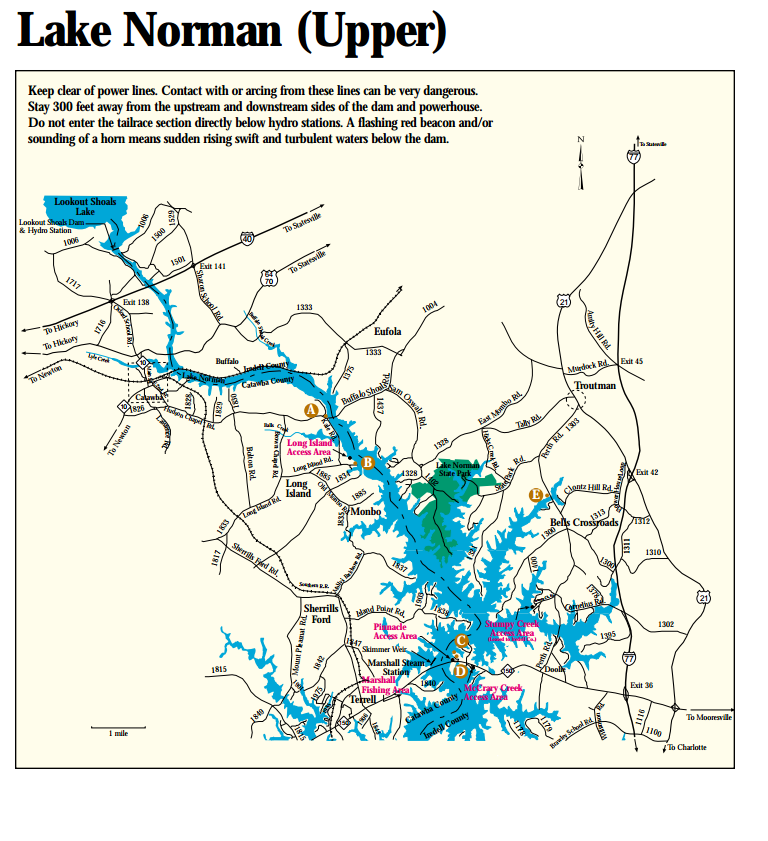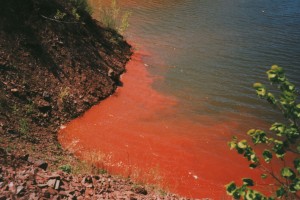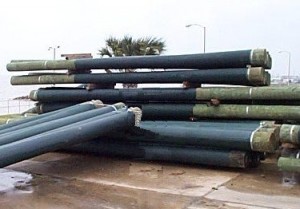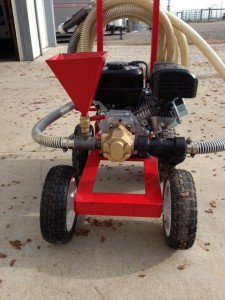Overview:
Gaining access to Lake Norman may be difficult if one does not have access to a private dock. At the moment, there is only one public swimming area for the entire lake, located in Lake Norman State Park (formerly Duke Power State Park). In addition, there are 11 public boat access ramps, 2 public fishing access areas, and 14 public marinas and other businesses, maps of which are below. Aside from these public places, anyone wishing to gain access to the lake must do so from a private dock, ramp, or marina. However, erecting a dock, ramp, or marina on Lake Norman is not the easiest thing to do. Below are some more detailed accounts of the important aspects of dock building, from the mouths of builders and owners.
Dock Building in a New Light:
Bob Wilson of the Coastal Resources Commission states “The whole purpose is to successfully develop our shoreline while protecting the environment. It gives me a different perspective on designing and building. I want the docks I build to blend as much as possible with the shoreline. For example, we use a lot of grays instead of white on our docks,” highlighting how the environment is a large consideration in the process. So, how does one go about starting to build a dock? First, a contractor must begin with permits, followed by “What I do is, I first pull up a GIS — that’s a satellite picture of your waterfront. It’s easy to see where the water gets shallow because it’s very light beige. We also look at the projection lines from the shore of your property — imaginary lines that make what’s called a ‘pier envelope’ projected out into the water from your land,” says Bob Wilson. “We also go to the site and take measurements. For the dock, depending on the design and where you’re going to put the boat, and what kind of boat, we need 10 feet of water at full pond. We’ve got a laser that determines on site the exact depth we have to work with.”
Mark Lancaster says, “If you have to dredge, that goes through the Army Corps of Engineers — you need an approval letter from them, and also from the State Department of Water Quality, and the State Historical Society in Raleigh.” This is on top of the permitting process that one must go through with Duke Energy and the county in which one resides.
A Closer Look:
First determine the soil characteristics of the lake bed. Docks are held up by ‘piles’ and must have firm soil to support pier structure. This is often accomplished with the use of GIS software.
Second, pilings must be chemically treated to resist rot (usually with sodium pentachloride, copper-chlorinated arsenate, or creosote). Pilings must be large enough to support joists, and long enough to be sunk deep in the ground to bear the weight put on them.
Third, a gasoline-powered water pump is used to suction water from the lake. This pump is attached to a water containment device. When all dredging activities cease, the water is returned to the lake.
Fourth, a jetting pipe must be built, which provides a stream of water to wash and blow out a hole for the piling to set into.
Fifth, lay out pilings using stakes.
Sixth, stand a piling up in the water, raise the jet pipe alongside it, and turn on the pump. The hole for the piling is created, and the piling must be steered down into the hole using water pressure and velocity.
Seventh, adjust the piling before the soil settles back in the hole. Once this step has been accomplished, construction can continue as it would if it were on land, as the pilings are the foundation of any dock.
Sources:
Anonymous
2014 Poly Zone Coated Pine Pilings. Electronic document, http://www.americanpoleandtimber.com/img/21_POLY_Zone_Coated_Pine_Pilings.jpg, accessed April 1, 2014.
Anonymous
Article Image. Electronic document, http://cdn.husqvarna.com/dimage.axd/newsArticleMainImage/hc150-0083/520×520/4e407aa2.png, accessed April 2, 2014.
Anonymous
Article Main Image. Electronic document, http://cdn.husqvarna.com/dimage.axd/newsArticleMainImage/hc150-0081/520×520/1c09d752.png, accessed April 3, 2014.
Anonymous
Pit Erosion. Electronic document, http://www.lakeaccess.org/russ/piterosion.jpg, accessed April 4, 2014.
Duke Energy
2014 Norman. Electronic document, https://www.duke-energy.com/pdfs/norman.pdf, accessed April 7, 2014.
Morano, Eloise
2006 Dock Drama. Charlotte Observer Lake Norman Magazine(May).
NCDCR
2014 North Carolina Office of Archives and History. Electronic document, http://www.history.ncdcr.gov/, accessed April 1, 2014.
NCDENR
2014 Division of Water Quality Resources. Electronic document, http://www.ncwaterquality.org/, accessed April 5, 2014.
Photography, Portland Oregon
Pilings on Columbia River 1. Electronic document, http://www.portlandground.com/archives/2006/11/pilings_on_columbia_river_1.php, accessed April 1, 2014.
Recreation, N.C. Division of Parks and
Lake Norman State Park. Electronic document, http://www.ncparks.gov/Visit/parks/lano/main.php, accessed March 1, 2014.
Robertson, Bob, and et al
How to Install Posts in the Water for a Dock or Pier. Electronic document, http://www.wikihow.com/Install-Posts-in-the-Water-for-a-Dock-or-Pier, accessed March 10, 2014.
Shoemaker, Monica
Damon Point Before Piling Removal. Electronic document,http://blog.seattletimes.nwsource.com/reeltimenorthwest/Damon%20Point%20before%20piling%20removal%20%20Photo%20Monica%20%20Shoemaker%20DNR.jpg, accessed April 4, 2014.
Supply, Utah Biodiesel
Staver12. Electronic document, http://www.utahbiodieselsupply.com/blog/wp-content/uploads/2013/05/staver12-225×300.jpg, accessed April 2, 2014.
USACE
2014 Headquarters U.S. Army Corps of Engineers. Electronic document, http://www.usace.army.mil/, accessed February 28, 2014.
